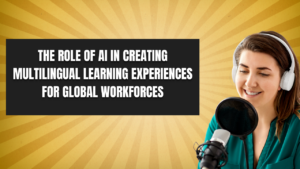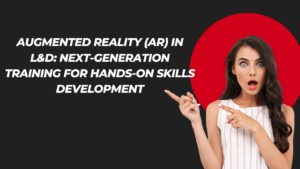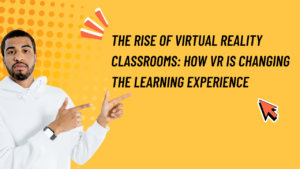The landscape of Learning & Development (L&D) is shifting rapidly, and with it, the way we approach corporate training. With employees’ expectations evolving and technology advancing, eLearning has become more than just a trend—it’s a necessity for organizations looking to stay competitive.
In fact, LinkedIn’s 2023 Workplace Learning Report highlights that 94% of employees would stay longer at a company that invests in their career development. As we dive into the future of corporate learning, these trends are shaping how we learn, train, and grow.
Let’s look at the 10 key trends in eLearning that are set to transform the future of L&D, making it more personalized, efficient, and aligned with modern workforce needs.
AI-Powered Learning Platforms
Best for: Enhancing Personalization and Efficiency
Artificial Intelligence (AI) is revolutionizing Learning Management Systems (LMS). AI can adapt employee learning paths based on their progress, challenges, and preferences, delivering a hyper-personalized learning experience. The beauty of AI in L&D is its ability to continuously analyze learner data and provide tailored recommendations, ensuring content remains relevant and practical.
Key Fact:
- According to PwC, AI-driven platforms improve employee performance by up to 40% due to personalized learning experiences.
The future of eLearning lies in the seamless use of AI to continuously fine-tune the learning journey, making it more intuitive and efficient for employees.
Immersive Learning with VR and AR
Best for: Providing Hands-On Training
Virtual Reality (VR) and Augmented Reality (AR) create learning environments that allow employees to experience real-world scenarios in a safe, controlled space. Whether simulating complex machinery operations or practicing customer service skills, immersive learning is helping organizations provide hands-on experiences crucial for skills mastery.
Key Fact:
- PwC’s 2021 study revealed that VR training boosted learner retention by 4 times compared to traditional methods.
As VR and AR evolve, we’ll see more businesses using them to create highly effective, real-world training scenarios—perfect for industries like healthcare, aviation, and customer service.
Microlearning
Best for: Delivering Bite-Sized, On-Demand Content
Time constraints are one of the biggest challenges in corporate learning. Microlearning, the practice of breaking down content into small, digestible chunks, has become an effective solution. This format allows learners to absorb knowledge in short, focused sessions and access content when it’s most convenient for them.
Key Fact:
- According to The Journal of Applied Psychology, microlearning boosts retention by 80%, making it one of the most effective methods for knowledge transfer.
Microlearning aligns perfectly with the needs of modern employees who demand flexibility, with many opting for quick bursts of learning that fit into their busy schedules.
Gamification
Best for: Boosting Engagement and Motivation
Gamification is more than just fun and games. Organizations can drive learner engagement, motivation, and even healthy competition by incorporating elements like points, badges, and leaderboards. When learners are rewarded for achieving milestones, it enhances their experience and encourages them to stay on track.
Key Fact:
- TalentLMS’s 2022 Gamification Survey found that 60% of organizations reported increased employee engagement with gamified training.
In the future, gamification will play an even more significant role in L&D, helping learners stay motivated and improving training completion rates.
Data-Driven Instructional Design
Best for: Tailoring Training to Learner Needs
Gone are the days of guessing whether training programs are effective. With data-driven insights, L&D teams can track learner progress, identify knowledge gaps, and optimize training content. By collecting and analyzing performance data, businesses can improve the quality of their programs, ensuring they meet both learner and organizational goals.
Key Fact:
- Gartner predicts that by 2025, 75% of organizations will use advanced data analytics to continuously optimize their L&D strategies.
The ability to make real-time adjustments based on data will be one of the most powerful tools in designing impactful, results-driven training programs.
Social Learning
Best for: Encouraging Peer-to-Peer Interaction
The future of learning is collaborative. Social learning encourages employees to engage with one another, share knowledge, and solve problems together. By integrating discussion forums, peer reviews, and collaborative tools within eLearning platforms, companies are fostering a learning culture where employees learn as much from each other as they do from instructors.
Key Fact:
- LinkedIn’s 2021 Workplace Learning Report found that 83% of employees learn more effectively from peers and experts within their organization.
As we move forward, organizations will place more emphasis on social learning to create communities that support continuous, collaborative development.
Learning in the Flow of Work
Best for: Seamless Learning Integration
Learning in the flow of work allows employees to access training and knowledge directly within their daily tasks. By integrating learning tools into work applications like Slack or Microsoft Teams, employees can consume microlearning content, ask for help, or review training materials without disrupting their workday.
Key Fact:
- Harvard Business Review reports that 58% of employees prefer learning to be integrated into their workflow, with easy access during tasks.
This seamless approach to learning will become the norm as companies move away from separate training modules toward embedded learning solutions that are easily accessible during day-to-day operations.
Hybrid and Remote Learning
Best for: Adapting to Modern Work Environments
The shift to remote and hybrid work has made virtual learning a cornerstone of corporate L&D strategies. As companies adopt flexible work arrangements, it’s essential that employees can access training remotely, collaborate with colleagues, and learn at their own pace, regardless of their physical location.
Key Fact:
- Gartner’s 2022 Talent Management Report found that 70% of organizations now use hybrid learning to train remote teams.
Remote and hybrid learning will continue to expand, making training more accessible for a global workforce and ensuring all employees have equal learning opportunities.
AI-Based Content Curation
Best for: Streamlining Content Delivery
AI is not only transforming the way we learn; it’s also changing how we find and organize learning content. AI-driven content curation helps LMS platforms recommend relevant courses, articles, or videos based on a learner’s preferences, job roles, or performance. This ensures that employees always engage with the most appropriate, up-to-date resources.
Key Fact:
- Forrester Research predicts that AI-powered content curation will help organizations reduce learning content creation time by 40% by 2025.
This technology will help companies create more efficient and effective training programs, delivering exactly what employees need without sifting through irrelevant materials.
Focus on Soft Skills and Leadership Development
Best for: Enhancing Communication and Leadership Skills
As automation takes over more technical tasks, the demand for soft skills such as emotional intelligence, communication, and leadership is rising. eLearning platforms will continue to expand in this area, offering training programs designed to build critical interpersonal skills and prepare employees for leadership roles.
Key Fact:
- LinkedIn’s 2023 report highlights that 87% of employers consider soft skills as critical for success in leadership roles.
Soft skills and leadership development will play an increasingly significant role in future L&D strategies, ensuring employees are ready for higher responsibilities and leadership positions.
Conclusion
The integration of advanced technologies and modern learning strategies is shaping the future of Learning & Development. From AI-driven learning platforms and immersive training environments to microlearning and social learning, these trends are revolutionizing how organizations approach employee growth and development. As companies continue to adopt these innovations, they will build stronger, more engaged, and highly skilled teams ready to tackle tomorrow’s challenges.
By staying ahead of these L&D trends, organizations can create more dynamic and efficient learning experiences, ensuring they remain competitive and continuously foster a culture of growth and development.









